OSCC is the sixth most common cancer worldwide and one of the leading causes of death especially in developing countries like India [1]. Cancer is hyperproliferative disorder which is usually managed with the help of different chemotherapeutics agents that are toxic, not only to cancer cells but also to the normal cells in many ways. In addition these agents are highly expensive and cannot be used for the prevention of cancer.
The traditional herbal medicines which have been used from ancient days in India are generally known to be free of any deleterious effects. They are inexpensive and effective [2,3]. Wheatgrass is the young grass of common wheat plant (Triticumaestivum Linn., family Poaceae) and it is also known as “green blood” because of its high chlorophyll content, i.e., 70% of its chemical composition. Moreover, it has structural similarity with haemoglobin and thus results in high oxygen supply to all the tissues [3]. Apart from these, it contains antioxidant enzymes superoxide dismutase and cytochrome oxidase that have the potential to convert reactive oxygen species to hydrogen peroxide and oxygen molecule. It also has ability to inhibit oxidative DNA damage [4].
The anticancer activity of alcoholic extract of wheatgrass on cervical cancer cell line has already been studied and the anticancer activity of alcoholic wheatgrass extract is proven [5]. The present need is to develop drugs that can potentially target cancer cells and not normal cells. We have carried out this study with the aim to check the inhibitory effect of aqueous wheatgrass extract on OSCC cell line (KB mouth cell line).
Materials and Methods
It was an ex vivo experimental study carried out at Sinhgad Dental College and Hospital, Pune, Maharashtra, India.
Wheatgrass Extract Preparation
Unpolished organic wheat grains were soaked in water overnight and then spread over soil in a plastic tray [6]. A thin layer of soil was spread over it and kept in covered balcony for eight days. On ninth day the young shoots of wheatgrass were harvested half inch above the soil. For preparation of aqueous extract, 250 gm of fresh wheatgrass was crushed in 250 ml of distilled water. This extract was then filtered and concentrated to dryness in a rotary evaporator at a controlled temperature of 50-60°C to get final volume of 25 mg. A 5 mg of this dry extract was then diluted in 5 ml of distilled water to prepare stock solution. From this stock solution six dilutions were made (25, 50, 100, 250, 500 and 1000 µg/ml).
Oral Squamous Cell Carcinoma Cell Line (KB Mouth) and Culture
OSCC cell line (KB mouth) was procured from National Centre of Cell Sciences; Pune, India and was used for this study. The cells were grown in Minimal Essential Medium (MEM) supplemented with antibiotics and 10% Fetal Bovine Serum (FBS) in 5% CO2 in humid condition at 37°C for 24 hours [7].
Treating OSCC cells with Various Concentrations of Aqueous Wheatgrass Extract
Day 1:
1×105 cells/ml were added in 96 well plate (cell count was taken on Neubauer’s chamber).
Then the plate was incubated at 37°C in a CO2 incubator for 24 hours.
Day 2:
After 24 hours incubation plate was observed under inverted microscope.
A 25 μg/ml, 50 μg/ml, 100 μg/ml, 250 μg/ml, 500 μg/ml 1000 μg/ml concentrations of test sample were prepared.
A100 μl of each test sample was added in three wells (triplicate). This was done to avoid the error.
After this plate was incubated at 37°C in a CO2 incubator for 24 hours.
Day 3:
After 24 hours incubation, plate was observed under inverted microscope.
Then10 μl of 5 mg/ml MTT reagent was added in each well.
The plate was wrapped in aluminum foil and incubated for four hours in CO2 incubator.
After four hours incubation, plate was removed and observed under inverted microscope.
The entire medium was removed by flicking the plate and 200 μl of acidic isopropanol was added in each well.
After one hour absorbance was measured at 492 nm on 96 well plate reader.
Various concentrations of aqueous wheatgrass extract were added to the well containing normal and cancer cell lines.
Cell viability assay was done to determine the proliferative activity of cells in the presence of extract. Cell viability of KB mouth cell line treated with and without aqueous extract of different concentrations was calculated by MTT assay (Sigma). The quantification of inhibition and proliferation of OSCC cells were done by Neubauer’s counting chamber and expressed in percentage.
Result
There was decrease in OSCC cells proliferation with increase in the concentration of aqueous extract of wheatgrass. The [Table/Fig-1] shows change in the OSCC cell viability and OSCC cell inhibition (expressed in percent) with increase in the concentration of aqueous wheatgrass extract. The representative images have been shown in [Table/Fig-2,3,4,5,6 and 7].
MTT assay showing increase in OSCC cell Inhibition (expressed In %) with increase in the concentration of aqueous wheatgrass extract.
| Test | Absorbance at 492 nm (Colorimetry method was used) | % cell Viability | % cell Inhibition |
|---|
| Well 1 | well 2 | well 3 | Mean |
|---|
| Figure Normal control | 0.372 | 0.377 | 0.368 | 0.372 | 100 | 0 |
| 25 μg/ml | 0.314 | 0.314 | 0.314 | 0.314 | 84.4 | 15.6 |
| 50 μg/ml | 0.290 | 0.280 | 0.285 | 0.285 | 76.6 | 23.4 |
| 100 μg/ml | 0.285 | 0.274 | 0.280 | 0.280 | 75.1 | 24.6 |
| 250 μg/ml | 0.262 | 0.282 | 0.262 | 0.272 | 73.3 | 26.0 |
| 500 μg/m | 0.261 | 0.267 | 0.262 | 0.264 | 71.0 | 29.0 |
| 1000 μg/ml | 0.214 | 0.244 | 0.229 | 0.229 | 58.6 | 41.4 |
There was no OSCC cells inhibition after incubating without wheat-grass extract.
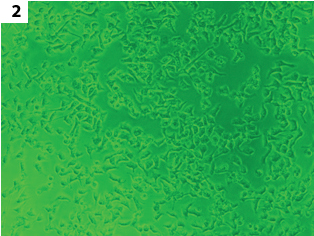
15.6% OSCC cells were inhibited after incubating with wheatgrass extract (25 µg/ml).
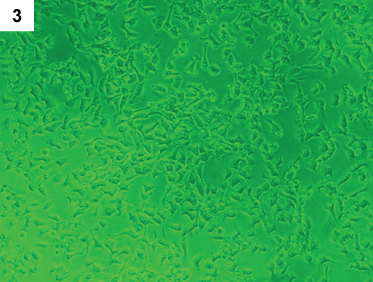
23.4% OSCC cells were inhibited after incubating with wheatgrass extract (50 µg/ml).
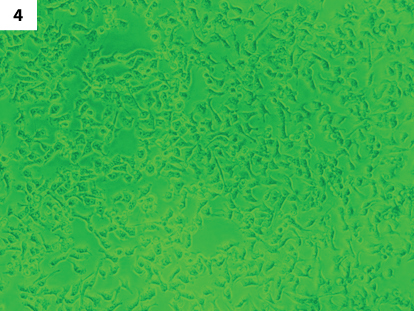
24.6% OSCC cells were inhibited after incubating with wheatgrass extract (100 µg/ml).
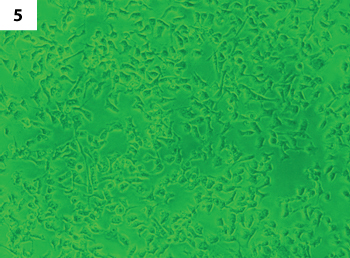
29% OSCC cells were inhibited after incubating with wheatgrass extract (500 µg/ml).
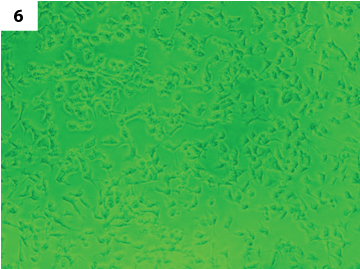
41.4% OSCC cells were inhibited after incubating with wheatgrass extract (1000 µg/ml).
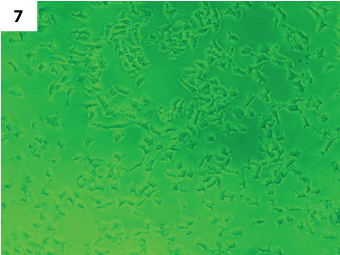
Discussion
The use of herb as medicine is practiced worldwide since ancient days. The wheatgrass has been traditionally used to treat various diseases and disorders [8]. Wheatgrass juice is rich in vitamin A, B complex, C and E [9]. It contains plethora of minerals like calcium, phosphate, zinc, boron, molybdenum, alkaline earth metals, potassium, selenium, etc., [10].
Acids like aspartic acid, glutamic acid, arginine, alanine and serine are also important constituents of wheatgrass [11].
High content of antioxidant enzymes like superoxide dismutase and cytochrome oxidase have capacity to convert free radicals like reactive oxygen species to hydrogen peroxide and oxygen molecule [12]. Chlorophyll has ability to induce mammalian phase 2 proteins that protect cells from harmful effect of oxidants and electrophiles. In addition to this, chlorophyll is structurally analogous to haemoglobin. The structure of these two compounds depicts a striking similarity, the only difference between the two is the nature of the central metal atom magnesium in chlorophyll and iron in haemoglobin. The structural similarity between the two compounds is the reason behind the increased oxygen supply to all cells including cancer cells which are vulnerable to high oxygen concentration [13,14]. This allows for the limited use of chlorophyll as a blood substitude.
Abscisic acid which is one of the components of the wheatgrass has ability to neutralise the effect of chronic gonadotropins and compounds similar to this hormone which has been found to be produced by cancer cells. Alkaline pH of wheatgrass also plays an important role in its anticancer approach in two ways, it helps to reduce the number of microbes in the diet which attenuates the incidence of secondary infections to a certain degree in the patient and the cancer cells succumb in a highly alkaline environment [3]. In this way, wheat grass possesses the ability to modify the physiological functions of cells and hence can act as anticancer agent. Anticancer activity of alcoholic extract of wheatgrass was studied on Hela cell line and results showed moderate anticancer activity. Blood building capacity of wheatgrass was also studied in Thalassemia patients [6].
Shrivastava P et al., has done a study with the aim to check the anti-cancer activity of ethanolic extract of Curcumin longa. They have found that the ethanolic extract of Curcumin longa showed more than 97% of cytotoxicity at 1000 µg/ml against cancer cells and concluded that it has potential anticancer activity [15]. Shivpuje P et al., has also done a similar type of study using Tulsi leaves extract and they found that aqueous Tulsi leaves extract has potent cytotoxic activity against oral cancer cells. Large number of plant extract has been reported to have capacity to prevent antiproliferative action against cancer cells and thus can be used in the cancer therapeutics [8].
In present study anticancer activity of aqueous extract of wheatgrass extract was checked on OSCC cells and concentration dependent cytotoxic effects were noted.
Limitation
Since the present study is done on OSCC cell line i.e., an ex vivo study, the results are subjected to technique sensitivity. Clinical trials on animals will give better indication for its pharmacological use.
Conclusion
As the concentration of aqueous extract increased from 25 µg/ml to 1000 µg/ml, percentage of cell inhibition was increased from 15.6% to 41.4 % in 24 hours. Hence we conclude that the therapeutic use of wheatgrass holds great promise in management of OSCC and further extensive research work is required in this field.
Funding: This research did not receive any specific grant from funding agencies in the public, commercial, or not-for-profit sectors.